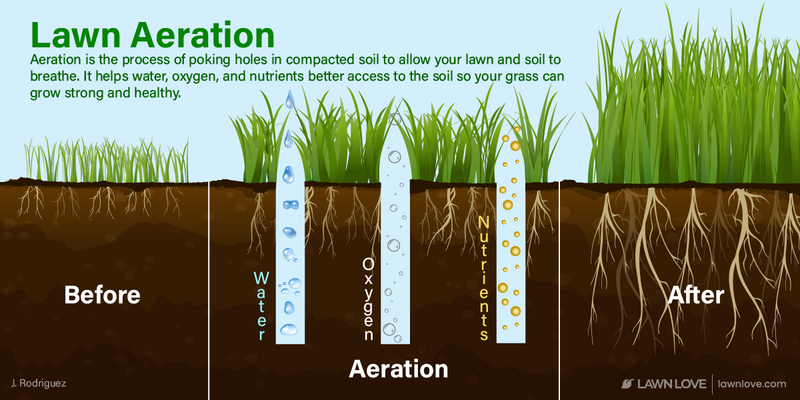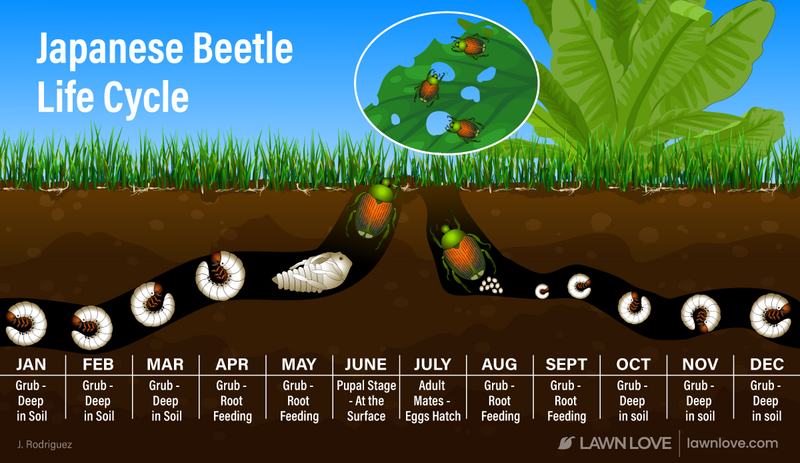
If your Columbia lawn needs a little help waking up from its winter slumber, we’ve got eight tips to help revive your lawn and make the transition into summer with strength and vigor.
1. Mow the lawn
Oh, your trusty, dusty lawn mower. You’ve missed it, haven’t you? Whether or not you’re ready to break out into a musical tribute to this three-season workhorse, spring in Columbia means the sounds of the combustion engine will soon be heard again across the land, er…lawns.
Plan to do your first mow of the season right before green up, sometime between April and mid-May. Clemson University experts recommend attaching the bagger for the first mow or hand-raking the lawn to remove any dead grass left over from the winter. (Don’t throw away this nutrient-rich material. Put it in the compost pile to recycle these nutrients back into the lawn once it breaks down.)
So, how tall should you mow? Take your standard summer mowing height and cut a little lower than that. Here are the recommendations for standard mowing heights for the three Columbia warm-season grasses and one cool-season grass. Take a smidge off of these heights for your first mows of the spring.
- Bermudagrass (common): 1-2 inches
- Bermudagrass (hybrid): ½ to 1 ½ inches
- Centipedegrass: 1 ½ – 2 inches
- Tall fescue: 2 ½ to 3 ½
- Zoysiagrass: 1-2 inches
2. Take a soil test
A great-looking summer lawn takes preparation, and spring is a good time to get a soil test. A soil test will tell you how much fertilizer you need (or don’t need). There is no way to guess what’s in your soil. Like your blood, you have to draw it and test it in a lab to get accurate results.
How often should you test? Clemson University recommends soil testing once per year.
Still not convinced? Think of it this way: Soil testing not only lets you know your nutrient levels, but it includes the pH, as well. The pH is important because your soil may be more or less able to uptake those nutrients based on the alkalinity or acidity of the soil. So, testing your soil saves you from wasting time and money and helps you have a healthier, greener lawn.
3. Hold the fertilizer
Cashier: “What kind of warm-season spring lawn would you like to order today?”
Customer: “Give me a strong green-up period with well-aerated soil, strong roots, and good top growth but hold the fertilizer, please.”
No fertilizer? Correct: Fertilizer is not recommended for warm-season central South Carolina lawns in early spring.
If you apply a spring nitrogen fertilizer and you have a late frost, this may injure the lawn. In addition, fertilizing too early may use too much of the plant’s carbohydrates, weakening its roots and lessening its disease resistance. So, if you want a healthy lawn, remember to hold off on the fertilizer until late spring or early summer.
Note: For cool-season tall fescue lawns, no fertilizer should be applied after March 15, but fall is the best time to fertilize tall fescue and other cool-season grasses.
4. Prevent weeds
Spring is the time to prevent those pesky summer annual weeds. Whether you choose natural or chemical pre-emergents, you’ve got to get the timing right to succeed. Crabgrass and other summer annuals germinate when the soil is above 55 degrees Fahrenheit for several consecutive days.
Seeds closer to the surface may germinate sooner and seeds buried deeper in the soil will be slower to pop their heads out come spring. Apply the pre-emergent when the soil temps are consistently around 50 degrees to prevent the seeds from germinating.
So, how do you know when to treat? In central South Carolina, this can be as early as mid-February, but guessing based on calendar dates won’t give you the best chance for success. To know for sure, you have to know the soil temperature.
If you prefer to go the old-fashioned route, use your Thanksgiving turkey thermometer to test the soil temperature in the top 1-2 inches of the soil profile. Or, if you’re more digitally inclined, check out an online soil temperature tracker, such as this one from Greencast. Type in your city, choose a date range and see current and historical temperatures on a handy graph.
Once the temperature is right, get out your pre-emergent of choice, and you’re on your way to fewer weeds this spring and summer.
5. Aerate or dethatch
If you have compacted soil or thatch, late spring (after your last frost date), is a good time to do these annual chores if you have warm-season grass. If you have tall fescue, wait until fall.
If you’ve never aerated or dethatched your lawn, you may not be familiar with these terms. To aerate the soil is to allow more air and water to flow into the root zone. The soil becomes less compacted and the increase in air and water flow allows for healthier root growth, which means a healthier lawn overall.

Most people rent a core aeration machine from a local big box store or hire out the job. A core aerator will remove plugs of soil a few inches into the ground. It will look like a flock of geese have visited your lawn for a while, but the plugs will dissolve on their own with a little time.
Note: If you apply a pre-emergent weed killer in February, wait until right before your next application to aerate. When you aerate, you will pull up weed seeds to the surface and disturb the barrier that the pre-emergent creates to prevent germination. So, right after you aerate, you’ll want to do another round of a pre-emergent to put down that protective barrier again.
If your lawn has a spongy feel when you walk over it, you may have thatch. Another way to check for thatch is to take a small core from the affected area. If there is a layer between the leaf blade and the soil that looks like a layer of matted roots or stems and squishes up and down as you press it, that’s thatch.

A little bit of thatch is helpful, but too much will prevent proper water flow to the roots of the lawn since the water tends to get stuck in the thatch layer. Here are different thatch tolerances for warm-season Columbia grasses and tall fescue:
- Bermuda: Dethatch when thatch levels rise above ½ inch.
- Centipedegrass: Dethatch when thatch levels rise above ¼ inch.
- Tall fescue: Thatch is not usually a problem for tall fescue lawns.
- Zoysiagrass: Dethatch when thatch levels rise above 1 inch.
Rent a dethatching machine at your local home improvement store or buy an inexpensive model yourself to get the job done. If you have a smaller area, you can buy a dethatching hand rake and use a little elbow grease to get the job done. (It’s hard work, though!)
6. Overseed
Does your grass have small, thinning patches? Put down extra grass seed to help your lawn’s mane look its fullest. This is called overseeding.
In warm-season lawns, overseeding is a late spring or early summer activity. (If you have tall fescue, wait until fall.) Clemson University recommends seeding or sodding patches of bermuda, centipede, and Zoysiagrass in May. Since May is relatively late in the spring season, you might as well aerate, fertilize, and overseed at the same time. The threat of frost goes down to 10% by April 17 in Columbia, so you’re safe to fertilize at this time.
Note: If you have a hybrid bermuda lawn, opt for sprigs, plugs, or sod instead of seed to maintain a high-quality lawn. Improved bermuda can be overseeded with seed, though. Most experts recommend fixing Zoysia patches with sod, sprigs, or plugs since this grass will establish at a snail’s pace and seed isn’t usually successful. Centipede is also relatively slow to establish, but sprigs, seed, and sod are available. Check out the grass-specific resources from Clemson in the “Resources” section below for more information.
7. Monitor the moisture level
South Carolina rains are usually sufficient to keep warm-season lawns properly hydrated while they are in a dormant state. However, if you don’t get rain at least once per month, you may need to turn on the faucet. For tall fescue, aim for one inch of water per week for most soils. If you have sandy soil, water your tall fescue lawn about ½ inch every three days.
Soil type also influences how much you’ll need to monitor the rain levels. You want to keep the lawn “just right” — not too wet and not too dry. Clay soils stay moist longer than sandy soils. If you have clay soils and adequate rainfall, you should be fine. If you have sandy soils, you may still need to check the lawn every few weeks. If you see wilting or if the grass doesn’t bounce back after you’ve walked on it, it probably needs a drink.
8. Manage pests
Most Columbia lawns grow one of three warm-season grasses (bermudagrass, centipedegrass, Zoysiagrass) or tall fescue, which is a cool-season grass. Tall fescue does not have any significant pest pressure in the spring, but here are a few tips to manage pests if you have a warm-season lawn.
- Mole crickets can be a problem in these warm-season grasses, but these insects are most commonly found along the coast and so won’t be a problem for most Columbia homeowners.
- If you’ve had white grubs in years past, now is a good time to check for those again. What is a white grub, you ask? White grubs are the immature or larval form of scarab beetles. They are about an inch long and have white, gray, or translucent bodies and brown heads. Their favorite snacks are grass roots. Your lawn can tolerate this to a certain point, but if the grub population is too high, you’ll need to take action.

Grub damage can look similar to many other lawn issues, including compaction, drought, and other insects. Typically, you’ll see irregular patches of dead, thin, or yellow grass, and when you pull on the grass in the affected area, it will pull out of the ground with little resistance because most of the roots have been eaten away.
How do you know if you have grubs? Here’s an easy way to check: Cut out a horseshoe (three sides) in a 1-foot area of turfgrass and peel away the sod. If there are grubs in the root zone, count how many. Repeat this test in a few other areas of the lawn and take an average per square foot.
Treatment thresholds range from 5-10 grubs per square foot on average but for the southern masked chafer can be up to 20 grubs per square foot. Treatment also depends on the health of the turf. Healthy turf can handle more grubs than stressed turf.
Take a photo of the grub you see and send a pic to your local Cooperative Extension office or check out Clemson University’s page on white grubs to identify the species. What species of grub you have can determine how many the lawn will handle before you need to intervene.
Source: University of New Hampshire
Resources for Columbia lawns
If you want to know more about yearly lawn maintenance in Columbia, check out these four lawn maintenance calendars from Clemson University.
- Bermudagrass Yearly Maintenance Program
- Centipedegrass Yearly Maintenance Program
- Tall Fescue Maintenance Calendar
- Zoysiagrass Yearly Maintenance Program
If you can’t bear to take your mower out of hibernation just yet, contact one of our Columbia lawn care pros to get your lawn off to a running start this spring.
Main Photo Credit: Aniket Bhattacharya | Unsplash